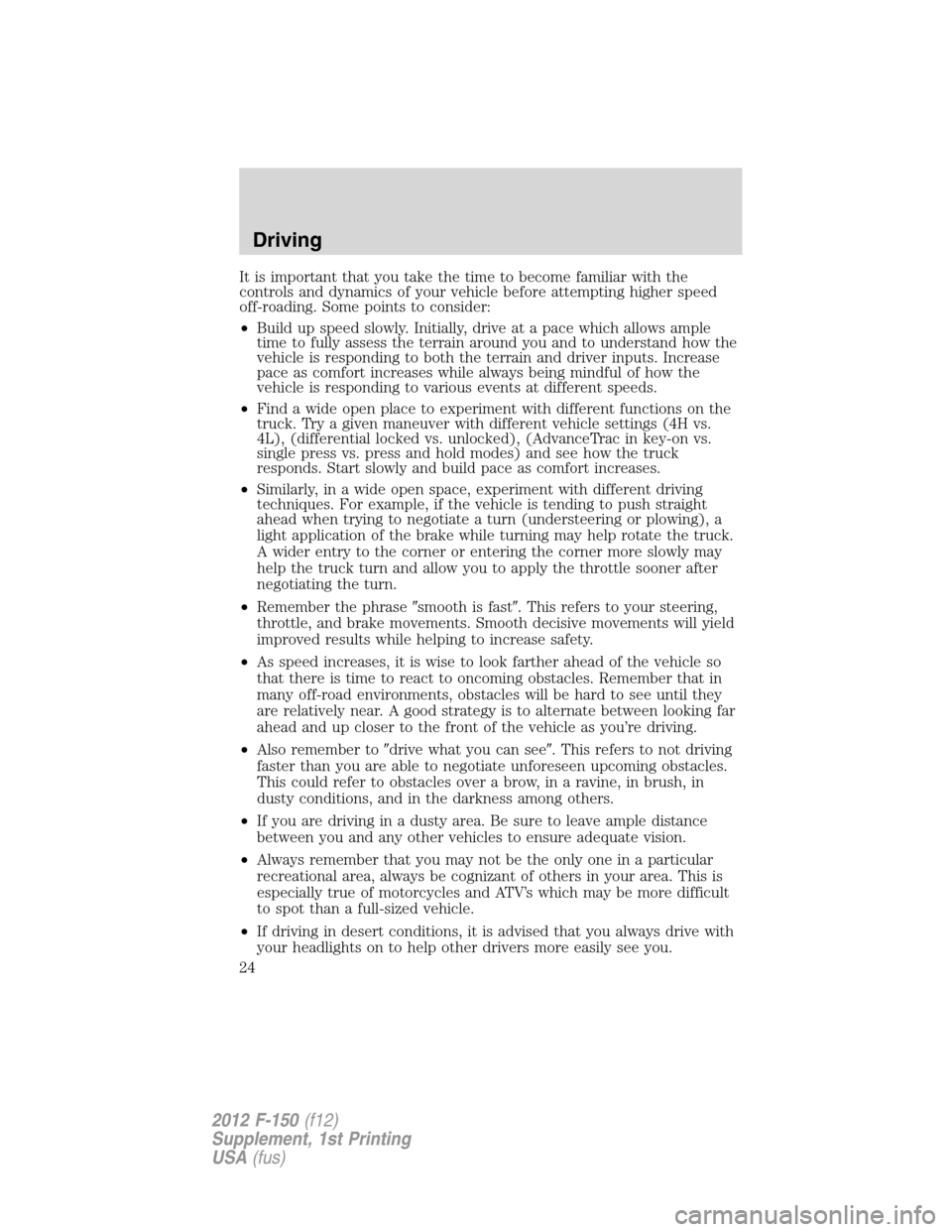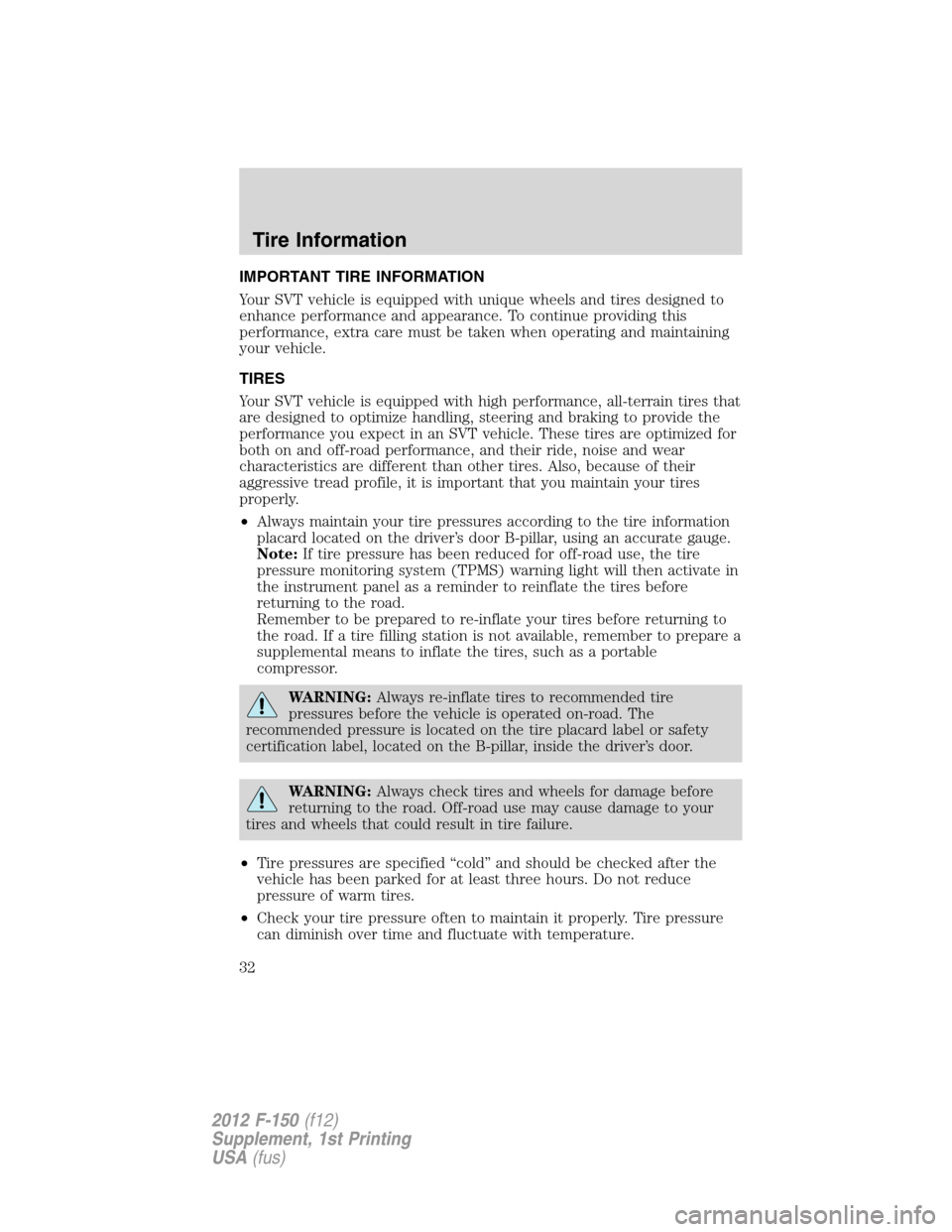Page 24 of 36

It is important that you take the time to become familiar with the
controls and dynamics of your vehicle before attempting higher speed
off-roading. Some points to consider:
•Build up speed slowly. Initially, drive at a pace which allows ample
time to fully assess the terrain around you and to understand how the
vehicle is responding to both the terrain and driver inputs. Increase
pace as comfort increases while always being mindful of how the
vehicle is responding to various events at different speeds.
•Find a wide open place to experiment with different functions on the
truck. Try a given maneuver with different vehicle settings (4H vs.
4L), (differential locked vs. unlocked), (AdvanceTrac in key-on vs.
single press vs. press and hold modes) and see how the truck
responds. Start slowly and build pace as comfort increases.
•Similarly, in a wide open space, experiment with different driving
techniques. For example, if the vehicle is tending to push straight
ahead when trying to negotiate a turn (understeering or plowing), a
light application of the brake while turning may help rotate the truck.
A wider entry to the corner or entering the corner more slowly may
help the truck turn and allow you to apply the throttle sooner after
negotiating the turn.
•Remember the phrase�smooth is fast�. This refers to your steering,
throttle, and brake movements. Smooth decisive movements will yield
improved results while helping to increase safety.
•As speed increases, it is wise to look farther ahead of the vehicle so
that there is time to react to oncoming obstacles. Remember that in
many off-road environments, obstacles will be hard to see until they
are relatively near. A good strategy is to alternate between looking far
ahead and up closer to the front of the vehicle as you’re driving.
•Also remember to�drive what you can see�. This refers to not driving
faster than you are able to negotiate unforeseen upcoming obstacles.
This could refer to obstacles over a brow, in a ravine, in brush, in
dusty conditions, and in the darkness among others.
•If you are driving in a dusty area. Be sure to leave ample distance
between you and any other vehicles to ensure adequate vision.
•Always remember that you may not be the only one in a particular
recreational area, always be cognizant of others in your area. This is
especially true of motorcycles and ATV’s which may be more difficult
to spot than a full-sized vehicle.
•If driving in desert conditions, it is advised that you always drive with
your headlights on to help other drivers more easily see you.
Driving
24
2012 F-150(f12)
Supplement, 1st Printing
USA(fus)
Page 31 of 36

OCTANE RECOMMENDATIONS
Regular unleaded gasoline with a
pump (R+M)/2 octane rating of 87 is
recommended. Some stations offer
fuels posted as�Regular�with an
octane rating below 87, particularly
in high altitude areas. Fuels with octane levels below 87 are not
recommended. Premium fuel will provide improved performance and is
recommended for severe duty usage such as trailer tow.
Do not be concerned if your engine sometimes knocks lightly. However, if
it knocks heavily under most driving conditions while you are using fuel
with the recommended octane rating, see your authorized dealer to
prevent any engine damage.
WHEELS AND TIRES
TiresLT315/70R17 BSW tires
WheelsSVT-Signature style, 17 in x 8.5 in
aluminum 6-spoke wheels
TIRE ROTATION
Because your vehicle’s tires perform
different jobs, they often wear
differently. To make sure your tires
wear evenly and last longer, have
them rotated.Note:The F-150
Raptor requires tire rotations every
5,000 miles (8,000 km). If you
notice that the tires wear unevenly,
have them checked.
SPARE TIRE AND WHEEL
Your vehicle is equipped with an LT315/70R17 spare tire. The spare
tire/wheel assembly has the same capability as the road tire/wheel
assembly, but is not equipped with a tire pressure monitoring sensor.
87(R+M)/2 METHOD
Maintenance
31
2012 F-150(f12)
Supplement, 1st Printing
USA(fus)
Page 32 of 36

IMPORTANT TIRE INFORMATION
Your SVT vehicle is equipped with unique wheels and tires designed to
enhance performance and appearance. To continue providing this
performance, extra care must be taken when operating and maintaining
your vehicle.
TIRES
Your SVT vehicle is equipped with high performance, all-terrain tires that
are designed to optimize handling, steering and braking to provide the
performance you expect in an SVT vehicle. These tires are optimized for
both on and off-road performance, and their ride, noise and wear
characteristics are different than other tires. Also, because of their
aggressive tread profile, it is important that you maintain your tires
properly.
•Always maintain your tire pressures according to the tire information
placard located on the driver’s door B-pillar, using an accurate gauge.
Note:If tire pressure has been reduced for off-road use, the tire
pressure monitoring system (TPMS) warning light will then activate in
the instrument panel as a reminder to reinflate the tires before
returning to the road.
Remember to be prepared to re-inflate your tires before returning to
the road. If a tire filling station is not available, remember to prepare a
supplemental means to inflate the tires, such as a portable
compressor.
WARNING:Always re-inflate tires to recommended tire
pressures before the vehicle is operated on-road. The
recommended pressure is located on the tire placard label or safety
certification label, located on the B-pillar, inside the driver’s door.
WARNING:Always check tires and wheels for damage before
returning to the road. Off-road use may cause damage to your
tires and wheels that could result in tire failure.
•Tire pressures are specified “cold” and should be checked after the
vehicle has been parked for at least three hours. Do not reduce
pressure of warm tires.
•Check your tire pressure often to maintain it properly. Tire pressure
can diminish over time and fluctuate with temperature.
Tire Information
32
2012 F-150(f12)
Supplement, 1st Printing
USA(fus)